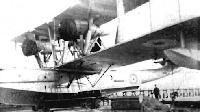Фотографии
-
Регистрационный номер: N185 BLACKBURN IRIS IV. This little-known version of the Iris open-sea reconnaissance flying-boat was experimentally fitted with three 800-h.p. Armstrong Siddeley Leopard engines in place of the usual Rolls-Royce Condors, the centre one being arranged as a pusher so that the slipstream flowed directly on to the tail-unit. The Mark IV, N185, is here seen at the Marine Aircraft Experimental Establishment at Felixstowe in 1933.
The main dimensions of the Iris series were: span 97 ft., length 70 ft., height 25 ft. 5 1/2 in.Самолёты на фотографии: Blackburn Iris / R.B.1 - Великобритания - 1926
-
FABIAN HERO. A two-seat, high-wing parasol monoplane, the Fabian Hero was built in Hungary during the early part of World War Il. The Hero was designed by Andras Fabian as a conventional tandem-seat primary trainer, with excellent all-round view for the pupil (front seat) and the instructor.
A number of Fabian Hero trainers is believed to have survived the years and to be in use with the O.M.R.E. elementary training schools. The in-line motor isa 105-h.p.licence-built Hirth H.M.504A. No other details a re available. The markings are those adopted when Hungary became an Axis co-belligerent.Самолёты на фотографии: Fabian Levente - Венгрия - 1940
-
Регистрационный номер: G-EBJK BRISTOL TYPE 91 BROWNIE. The Brownie was one of the entries in the Air Ministry's Two-seat Light Aeroplane Competition at Lympne in 1924. The Mark I illustrated, G-EBJK, was a metal version, with a 33-h.p. Bristol Cherub engine. The two Type 91 Mark IIs, G-EBJL and JM, had metal fuselages and wooden cantilever wings. Flown by Captain Cyril Uwins, then chief test pilot to the Bristol Aeroplane Company, the Mark I gained the second prize of ?1,000 at Lympne, when its maximum speed was 65.19 m.p.h. and its lowest speed 38.73 m.p. h. It flew 512.5 miles in 10 hours 21 minutes.
The Mark I had a span of 30 ft. 7 in., the Mark 11, 36 fl. 7 in. The empty weight was 500 lb. and the loaded weight 870 lb.Самолёты на фотографии: Bristol Brownie / Type 91 - Великобритания - 1924
-
GRAHAME-WHlTE GANYMEDE. The F.IV Ganymede was designed as a long-range day bomber just before the Armistice in 1918 and was not produced in quantity. It was a twin-fuselage biplane with two 270-h.p. Sunbeam Maori engines driving tractor airscrews, and a third Maori at the rear of the central nacelle driving a pusher propeller. Originally 400-h.p. Liberty engines were to have been fitted.
The wing span was 89 ft. 3 in. and the length 49 ft. 9 in. With the Maoris the maximum speed at sea-level was 105 m.p.h. and the endurance 9 hours. The loaded weight was 16,000 lb.
By the nose of the Ganymede is the 20-ft.-span Grahame-White Bantam sporting biplane (80-h.p. Le Rhone).Самолёты на фотографии: Grahame-White Bantam - Великобритания - 1919Grahame-White E.IV Ganymede - Великобритания - 1918



